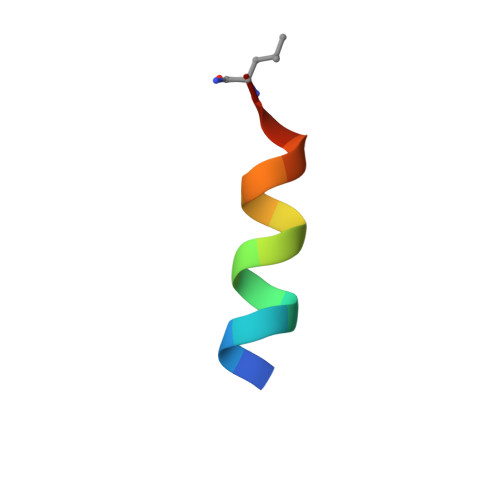Antimicrobial and Anticancer Properties of Synthetic Peptides Derived from the Wasp Parachartergus fraternus.
Muller, J.A.I., Lawrence, N., Chan, L.Y., Harvey, P.J., Elliott, A.G., Blaskovich, M.A.T., Goncalves, J.C., Galante, P., Mortari, M.R., Toffoli-Kadri, M.C., Koehbach, J., Craik, D.J.(2021) Chembiochem 22: 1415-1423
- PubMed: 33244888
- DOI: https://doi.org/10.1002/cbic.202000716
- Primary Citation of Related Structures:
7JGX, 7JGY, 7JHF - PubMed Abstract:
Agelaia-MPI and protonectin are antimicrobial peptides isolated from the wasp Parachartergus fraternus that show antimicrobial and neuroactive activities. Previously, two analogues of these peptides, neuroVAL and protonectin-F, were designed to reduce nonspecific toxicity and improve potency. Here, the three-dimensional structures of neuroVAL, protonectin and protonectin-F were determined by using circular dichroism and NMR spectroscopy. Antibacterial, antifungal, cytotoxic and hemolytic activities were tested for the parent peptides and analogues. All peptides showed moderate antimicrobial activity against Gram-positive bacteria, with agelaia-MPI being the most active. Protonectin and protonectin-F were found to be toxic to cancerous and noncancerous cell lines. Internalization experiments revealed that these peptides accumulate inside both cell types. By contrast, neuroVAL was nontoxic to all tested cells and was able to enter cells without accumulating. In summary, neuroVAL has potential as a nontoxic cell-penetrating peptide, while protonectin-F needs further modification to realize its potential as an antitumor peptide.
- Institute for Molecular Bioscience, Australian Research Council Centre of Excellence for Innovations in Peptide and Protein Science, The University of Queensland, Brisbane, Queensland, 4072, Australia.
Organizational Affiliation:
















